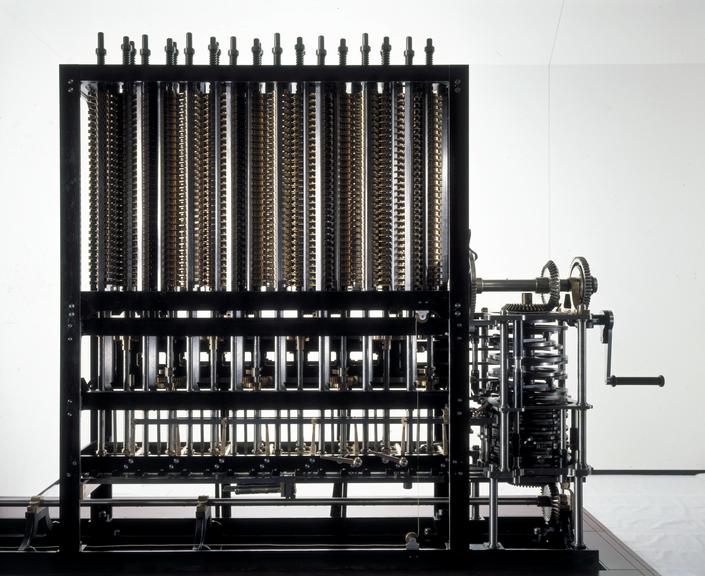Charles Babbage wrote a paper to the Royal Astronomical Society on June 14, 1822, announcing the Difference Engine. It was the first mechanical calculator and precursor to the computer. While Babbage failed to produce both the Analytical Engine and Difference Engine that he had designed, it was not failure in himself but failure in the technology of the day (think “Back To The Future III” and that huge box of vacuum tubes on the front of the Delorean).
This picture is from the Science Museum of London:

From Bits & Chips:
The man who invented the computer but never built one
Charles Babbage (1791-1871) was a man of many interests. He achieved notable results in cryptography, invented the cow-catcher for trains and engaged himself in public campaigns against nuisances, including the dangerous practice of boys running their iron hoops underneath horses. Today, he’s most famous for his pioneering efforts in computing. Like Alan Turing, Babbage invented the computer from scratch but never managed to build one. And also like Turing, his intellectual tour de force was only truly recognized after his death.
Over his lifetime, Babbage envisioned several mechanical calculating machines he called engines. The first one, the Difference Engine, was designed to solve polynomial equations using the mathematical technique of finite differences. This method reduces multiplication and division to addition, which is much easier to implement with the rods, gears, levers and linkages that were at the disposal of the Victorian-era gentleman-engineer. Two hundred years ago this week, Babbage presented his first paper on the Difference Engine to the Royal Astronomical Society, kicking off a visionary if troublesome pursuit that inspires awe even today.
There are other articles on Babbage and his invention:
i-programmer.info: 200 Years Ago Charles Babbage Proposed His Difference Engine
Spectrum.ieee: Charles Babbage’s Difference Engine Turns 200; Error-riddled astronomical tables inspired the first computer—and the first vaporware
History Extra: Why we should remember the public announcement of the Difference Engine
In 1985, nearing the 200th anniversary of Babbage’s birth, funding was provided to build the Difference Engine according to his designs, and it was completed by 2002. It worked. If the quality of parts machining available in the 20th century had been available in the early 19th century, the industrial revolution and world political history (e.g. the use of the DE for artillery measurement and firing) would have been very different. From the Computer History Museum:
In 1985 the Science Museum in London set out to construct a working Difference Engine No. 2 built faithfully to Babbage’s original designs dating from 1847-9. The project was led by the then Curator of Computing, Doron Swade. The purpose of the project was both to memorialize Babbage’s work in time for 200th anniversary, in 1991, of Babbage’s birth, and at the same time to resolve two nagging questions: could Babbage have built his engine, and had he done so, would it have worked?
[. . .]
The completed machine works as Babbage intended. Its 8,000 parts are equally split between the calculating section and the output apparatus. It weighs five tons and measures seven feet high, eleven feet long and is eighteen inches deep at its narrowest. As a static object it is a sight to behold – a sumptuous piece of engineering sculpture. In operation it is an arresting spectacle.

I’d take issue with the claim that the Difference Engine was the first computer. What about the Antikythera Mechanism?
I visited the Science Museum went the working Difference Engine was initially displayed, along with an exhibition on its design, development, etc. They had models (and at least one actual example — a wooden machine — from the time) of mechanical calculators with preceded Babbage’s attempt. (From memory, none of those predecessors worked as well as the Difference Engine; they frequently had problems with wear-and-tear, and most lacked a printer — and it’s Babbage’s printer which was critical to the Difference Engine in terms of seriously reducing errors.) In addition, they claimed they quality of the parts-making in his time was entirely sufficient; the claim that is why no Difference Engine was built is apparently false. As a reminder, whilst the Science Museum team used modern equipment, the tolerances, etc., used were those of Babbage’s time — yet it worked. That claim the parts couldn’t be made in Babbage’s time is a nonsense. The exhibition instead established the case it was never completed for at least two reasons: Babbage (apparently) was not a good project manager, and (less contentious) eventually got stuck into designing the more ambitious Analytical Engine.
I can’t think of Babbage without also thinking Ada Lovelace.
(Well, that was the Analytical Engine)
For anybody interested in Babbage, I highly recommend Sydney Padua’s book, “The Thrilling Adventures of Lovelace and Babbage”. Sydney is by profession a movie animator, but she is a bit of a polymath and she got fascinated by the friendship of Ada Lovelace and Babbage, so she created online a series of cartoons that took true incidents from their lives and reimagined them as comic (mis)adventures of the most ridiculous “superheroes” imaginable. When she got invited to make the book, she kept in many of her delightfully silly cartoons, but she added tons of footnotes that explain the true biographies of these people.